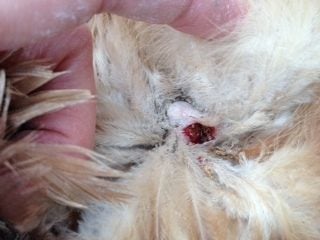- Apr 29, 2013
- 32
- 1
- 24
Hey all.
Well, this one is definitely for the well experienced poultry person.
We were looking at the hens lice situation when we came across this. There are 3(that we have found so far) very obvious lumps, very firm feeling. One of them had a crusty brown scab on it, so I carefully picked it off with the tips of sanitized scissors. A lot of dark sawdust looking stuff came out as well as what looked like little pieces of grit. Not much blood at all. I flushed it out with Vetericyn but there still seemed to be solids inside. The other two cysts appear to contain something white underneath. It's fairly easy to tell since the skin is so stretched thin.
Since our plan was to bathing them and dust for lice(after they dried off), we held off since we weren't sure if a bath would be good for the open wound. So, we went ahead and dusted them without bathing them. The thought of little lice getting into the wound was just not appealing.
So, now what... I am prepared to use a fresh razor blade/bactine for numbing/Oxine solution for serious disinfecting/Vetericyn for follow up..... for surgery to open up the cyst and clean it out. I'm already scheduled to drop off a poop sample to the vet tomorrow, so I was thinking I could also drop off a bit of what's inside the cyst as well.......
All the googling has led to very little information, other than it seems obvious that the other two cysts could burst. Considering that the one already did, and the hen didn't die, leads me to consider waiting for the cysts to take their natural course? I have no idea.



The top photo shows the location of the wound, at the base of the spine by the tail.
The second and third are just closer up shots of the wound. The scab has been removed and one of the other lumps can be clearly seen next to the wound.
Thanks to anyone who might have some insight.
Well, this one is definitely for the well experienced poultry person.
We were looking at the hens lice situation when we came across this. There are 3(that we have found so far) very obvious lumps, very firm feeling. One of them had a crusty brown scab on it, so I carefully picked it off with the tips of sanitized scissors. A lot of dark sawdust looking stuff came out as well as what looked like little pieces of grit. Not much blood at all. I flushed it out with Vetericyn but there still seemed to be solids inside. The other two cysts appear to contain something white underneath. It's fairly easy to tell since the skin is so stretched thin.
Since our plan was to bathing them and dust for lice(after they dried off), we held off since we weren't sure if a bath would be good for the open wound. So, we went ahead and dusted them without bathing them. The thought of little lice getting into the wound was just not appealing.
So, now what... I am prepared to use a fresh razor blade/bactine for numbing/Oxine solution for serious disinfecting/Vetericyn for follow up..... for surgery to open up the cyst and clean it out. I'm already scheduled to drop off a poop sample to the vet tomorrow, so I was thinking I could also drop off a bit of what's inside the cyst as well.......
All the googling has led to very little information, other than it seems obvious that the other two cysts could burst. Considering that the one already did, and the hen didn't die, leads me to consider waiting for the cysts to take their natural course? I have no idea.
The top photo shows the location of the wound, at the base of the spine by the tail.
The second and third are just closer up shots of the wound. The scab has been removed and one of the other lumps can be clearly seen next to the wound.
Thanks to anyone who might have some insight.




 Somewhere along the way, these ladies have become more than just egg layers. I might not have the money for vet visits like that, in the future, but the vet was adamant about giving her a call with ANY question, and she'd do her best to resolve it over the phone, no charge. So, I like having her available, and if paying a little money one time helps "cut costs" in the future, I'm all for it. Also, we realize that education can be very expensive, but the knowledge will last for years and make us better chicken people for the future. Maybe I'm just rationalizing the $$ spent
Somewhere along the way, these ladies have become more than just egg layers. I might not have the money for vet visits like that, in the future, but the vet was adamant about giving her a call with ANY question, and she'd do her best to resolve it over the phone, no charge. So, I like having her available, and if paying a little money one time helps "cut costs" in the future, I'm all for it. Also, we realize that education can be very expensive, but the knowledge will last for years and make us better chicken people for the future. Maybe I'm just rationalizing the $$ spent